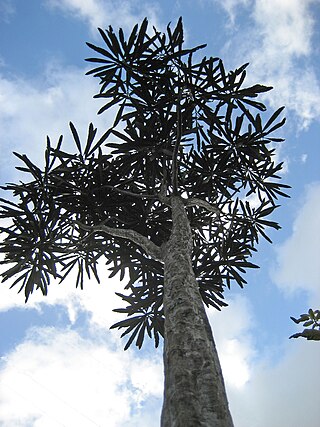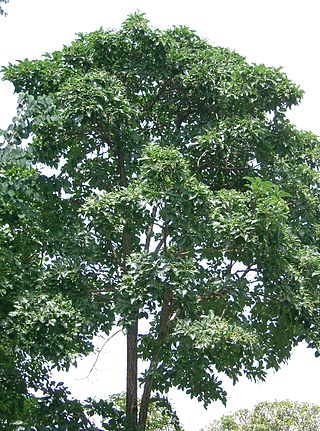
Oleaceae, also known as the olive family or sometimes the lilac family, is a taxonomic family of flowering shrubs, trees, and a few lianas in the order Lamiales. It presently comprises 28 genera, one of which is recently extinct. The extant genera include Cartrema, which was resurrected in 2012. The number of species in the Oleaceae is variously estimated in a wide range around 700. The flowers are often numerous and highly odoriferous. The family has a subcosmopolitan distribution, ranging from the subarctic to the southernmost parts of Africa, Australia, and South America. Notable members include olive, ash, jasmine, and several popular ornamental plants including privet, forsythia, fringetrees, and lilac.
Ironwood is a common name for many woods or plants that have a reputation for hardness, or specifically a wood density that is heavier than water, although usage of the name ironwood in English may or may not indicate a tree that yields such heavy wood.

Pseudopanax is a small genus of 7 species of evergreen plants which are endemic to New Zealand. Flowers of the genus occur in terminal umbels.

Pseudopanax crassifolius, the horoeka or lancewood, is a New Zealand native tree belonging to the family Araliaceae. It is found throughout New Zealand from sea level up to about 750 m. The juvenile form, which lasts between 15 and 20 years, is very easily recognized. The leaves are stiff and leathery with a prominent central rib, about 1 cm wide and up to 1 m long with irregular teeth, all growing downwards from a central stem. The young trunk has characteristic vertical swollen ridges. As the tree gets older the stem begins to branch, producing a bushy top, and the leaves become wider and shorter, losing their teeth. It is only when the tree is mature that it adopts a typical tree shape.

Chionanthus, common name: fringetrees, is a genus of about 140 species of flowering plants in the family Oleaceae.

Chionanthus virginicus is a tree native to the savannas and lowlands of the northeastern and southeastern United States, from Massachusetts south to Florida, and west to Oklahoma and Texas.

Melicytus crassifolius is an ornamental plant of Violaceae family, which is native to New Zealand.

Cheirolophus crassifolius, the Maltese centaury, Maltese rock-centaury or Widnet il-Baħar, is a species of flowering plant in the family Asteraceae. It is endemic to Malta, where it has been the national plant of Malta since 1973. Its natural habitats are cliffs and coastal valleys. It is threatened by habitat loss.

Chionanthus retusus, the Chinese fringetree, is a flowering plant in the family Oleaceae. It is native to eastern Asia: eastern and central China, Japan, Korea and Taiwan.
Chionanthus albidiflorus is a species of flowering plant in the family Oleaceae. It is endemic to Sri Lanka.

Chionanthus ramiflorus, commonly known in Australia as northern olive or native olive, is a species of plants in the olive family Oleaceae. It is native to India, Nepal, northeastern Australia (Queensland), New Guinea, the Philippines, southern China and Taiwan.

Melicytus is a genus of flowering plants in the family Violaceae. Hymenanthera is a synonym.

Hosackia crassifolia, synonym Lotus crassifolius, is a species of legume found in the western United States. It is known by the common names big deervetch and broad-leafed lotus.

Ceanothus crassifolius is a species of flowering shrub known by the common name hoaryleaf ceanothus. This Ceanothus is found throughout the coastal mountain ranges of the southern half of California, and its range extends into Baja California.
Chionanthus callophyllus grows as a tree up to 30 metres (100 ft) tall, with a trunk diameter of up to 30 centimetres (12 in). The bark is white, grey or brown. The flowers are pale green or white. Fruit is purple and round, up to 2.5 centimetres (1 in) in diameter. The specific epithet callophyllus is from the Greek meaning "beautiful leaf". Habitat is lowland forest, sometimes in swamps, from sea-level to 500 metres (1,600 ft) altitude. C. callophyllus is found in Thailand, Malaysia and Indonesia.
Chionanthus pluriflorus is a tree in the family Oleaceae. The specific epithet pluriflorus means "many-flowered".
Chionanthus polycephalus is a tree in the family Oleaceae. The specific epithet polycephalus means "many-headed", referring to the inflorescence.
Chionanthus polygamus is a tree in the family Oleaceae. The specific epithet polygamus refers to the tree having both unisexual and bisexual flowers.
Chionanthus quadristamineus, commonly known as the blue plum, is a flowering plant in the olive family. The specific epithet refers to the four stamens in the flowers.

Chionanthus pubescens is a tree in the family Oleaceae. It grows as a deciduous species and is sometimes cultivated as an ornamental tree.












